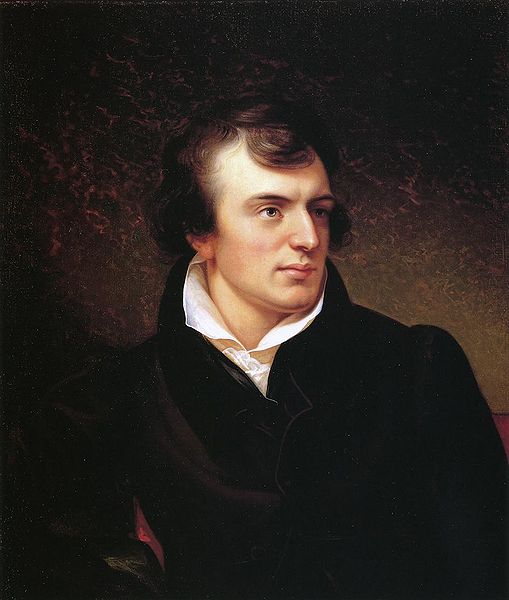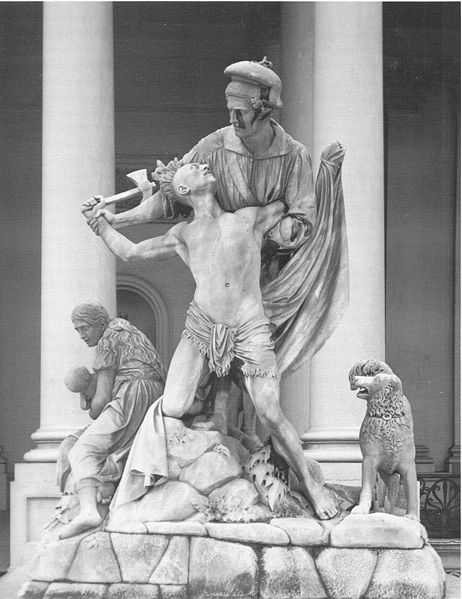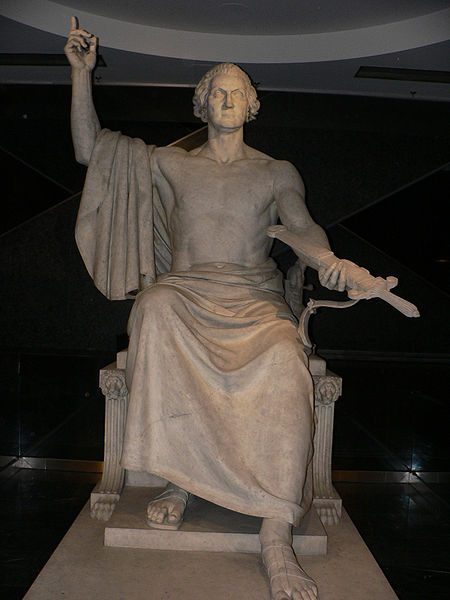<Back to Index>
- Philosopher Moses Mendelssohn, 1729
- Sculptor Horatio Greenough, 1805
- Algerian Political and Military Leader Abd al-Qadir al-Jaza'iri, 1808
PAGE SPONSOR

Horatio Greenough (1805 – 1852) was an American sculptor best known for his United States government commissions The Rescue (1837 – 50) and George Washington (1840).
The son of David and Elizabeth Bender, he was born in Boston on September 6, 1805, into a home with ethics for honesty and emphasis on good education. Horatio sparked an interest in artistic and mechanical hobbies, showing his native skills and talents at a young age. Particularly attracted to chalk, around the age of 12 he made a chalk statue of William Penn, known as his earliest work of record. Horatio also experimented with clay, from which he learned from Solomon Willard. He also learned how to carve with marble under instruction from Alpheus Cary. Horatio seemed to have a natural talent for art, yet his father wasn’t fond of the idea of this as a career for Horatio.
In 1814 Horatio Greenough enrolled at Phillips Academy, Andover, and in 1821 he entered Harvard University. There he found a passion in works of antiquity and devoted much of his time to reading literature and works of art. With a plan to study abroad, he learned Italian and French, but also still studied anatomy and kept modeling sculptures. While attending Harvard he came across his first crucial influence. Washington Allston was more than a mentor, but a close friend who enlightened and inspired Horatio. He even molded a bust of Washington. Before graduating from Harvard, he sailed to Rome to study art where he met the painter Robert W. Weir, while living on Via Gregoriana. These two became close friends and studied together the Renaissance and works of antiquity. Favorites of theirs were the Laocoon group of the Vatican structure galleries and the Apollo Belvedere. During Horatio’s time spent in Rome he created many busts, as well as a full-size statue of the Dead Abel, and a portrait of himself. He returned to Boston in May 1827 with Weir, after recovering from an attack of malaria. He then modeled more busts such as Josiah Quincy, president of Harvard, Samuel Appleton and John Jacob Astor. Horatio’s recognition was still not seen, so in an attempt to establish a successful reputation he sought out to make a portrait of President John Quincy Adams. His plan worked as he really displayed a style of naturalism in this piece as he did in many other works.
His sculptures reflected truth and
reality, but also ancient classical aesthetic ideals which he learned
from Washington
Allston. Many of Horatio’s captured works were done in Florence, Italy, where he spent most of his
professional life. His sculpture The Rescue (1837 – 1850) and his over
life-size
George Washington (1840)
both
derived from United States government commissions. Some of his
other most famous and important sculptures include: James Fenimore
Cooper, 1831, Castor and
Pollux, 1847, Marquis de
Lafayette,
1831-32. Along with sculpture masterpieces he created, there are
numerous drawings he also created which are displayed at the Middlebury
College Museum of Art's exhibition. Greenough’s
probably
most
enduring achievements are his essays on art. Here Greenough
repeatedly criticized contemporary American architecture for its
imitation of European historical building styles, wrote
enthusiastically about the beauty of animal bodies, of machine
constructions, and of ship design, and argued that as to architecture,
formal solutions were inherent in the functions of the building; in
this he anticipated the later functionalist thinking. The origin of the
phrase form follows
function is
often, but wrongly, ascribed to Greenough, although the theory of
inherent forms, of which the phrase is a fitting summary, informs all
of Greenough's writing on art, design, and architecture. The phrase
itself was coined by the architect Louis Sullivan,
Greenough's
much
younger compatriot, in 1896, some fifty years after
Greenough's death. Greenough, just as Sullivan himself, was influenced
by the transcendentalist thinking and the unitarian religion of Ralph Waldo
Emerson who
wrote, e.g., in his essay on "Nature" (1836), that "Nature who made the
mason, made the house." Greenough's writings were for a long time
largely forgotten, and were rediscovered only in the 1930s; in 1947 a
selection of his essays was published under the title Form and Function:
Remarks on Art by Horatio Greenough. Although
Greenough was generally healthy, in December 1852 he contracted a
severe fever. On December 18, after two weeks of this high fever he
died at the age of 47 in Somerville,
near Boston. Greenough worked hard to gain the recognition, yet still
little is focused upon him. As one of America's first sculptors to gain
international fame, he is historically important.

